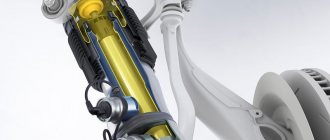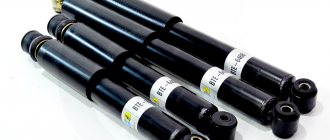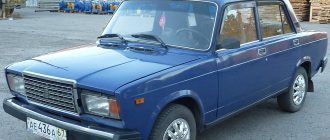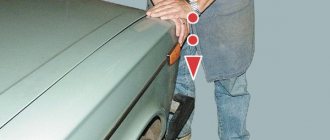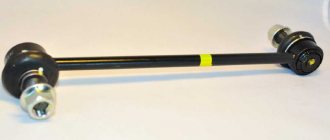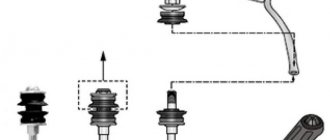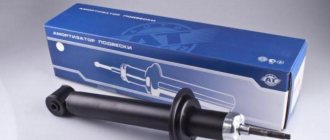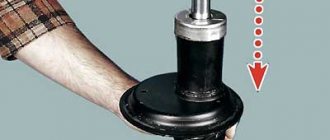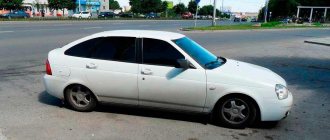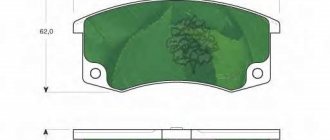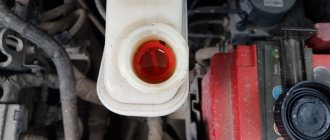Signs of shock absorber malfunction, replacement time
Since shock absorbers are constantly under load, they are subject to accelerated wear. Therefore, the racks need periodic replacement. How do you know how long the racks have left and whether it’s time to change them? The service life is specified in the vehicle maintenance regulations. In addition, there are signs of breakdown and accelerated wear:
- The car jumps sharply when driving over bumps.
- After “working out” the obstacle, the suspension oscillations continue.
- Liquid is leaking from the shock absorber strut or streaks are visible.
- Corrosion damage is visible on the body.
- When the shock absorber is compressed, a creaking or knocking noise is heard. Sometimes they say that the racks “squeak.”
- Handling deteriorates when driving on uneven roads.
- There is a noticeable decrease in comfort, the car shakes on uneven surfaces.
If any of these symptoms appear, it is necessary to undergo suspension diagnostics in order to more accurately determine the cause. It is also necessary to change the struts after mechanical damage, for example, after an accident.
The principle of operation of the front struts
To understand how the front shock absorber struts of a vehicle function, the MX should be divided into two main structural elements - a spring and a shock absorber. They are the ones who put the whole mechanism into action.
Spring
The main element of this part is designed to level out a variety of defects in modern road surfaces. It is also necessary to reduce vibration activity, which is reflected on the body during movement. When moving along a heavily broken road, it is thanks to the spring that the driver only feels the smooth rocking of the car. the spring absorbs the most powerful shocks, that is, completely dampens them.
The metal from which the spring is made must have optimal elasticity. Typically, the steel used is one that is optimally suited for a specific vehicle brand, its weight and general specialization.
The spring is installed with one side in a special cup of the rack, and the other part passes through a rubber spacer, which, in turn, rests against the body.
Shock absorber
This is the stand itself, which, when compared with the same spring, is a more complex part in its design. Here are the most basic design features:
- A two-chamber cylinder along which a piston moves, pre-attached to a rod. It is this that is filled with gas or liquid.
- The working composition circulates in the inside of both chambers, on the basis of which all struts, like standard shock absorbers, are divided into several types.
The main task of a shock absorber is to dampen vibrations that come from the spring. The depreciation procedure implies a serious increase in the level of pressure generated by the internal part of the part. Its reduction is carried out due to special valves, which are located directly on the piston. Depending on the general position, the elements automatically close and open so as to effectively regulate the applied loads.
This is interesting: What to do if the Chevrolet Cruze does not start, how to fix it
Do-it-yourself installation of new ones, after disassembly or repair
Proceed in reverse order.
- Thoroughly clean the mounting lugs. If necessary, remove corrosion and paint damaged areas.
- Check the condition of the mounting bolts. If there are grooves, cracks and corrosion holes, we replace them with new ones.
- When installing combined struts (spring + shock absorber), install the spring tie.
Clamps can be used
- We secure the upper bowl (eye) without tightening the nut all the way.
- Using a jack, align the lower eye with the stand.
- We tighten the fastener without tightening it.
- We install the wheel, lower the car into the transport position or set the suspension arm to a typical level for driving.
- Tighten all nuts using a torque wrench.
Procedure
To change the front struts, for example, on a Hyundai Getz, you need to perform a number of the following manipulations:
- Remove the engine compartment seal, as well as other elements that prevent access to the upper strut support.
- After removing the plug, unscrew the nut securing the strut rod to the upper support. This is done with a head with an extension and a wrench while the car is on wheels and the rack is not removed. It is much more difficult to do this with it removed, because you will have to look for a tool to fix the rod from twisting.
- Loosen the wheel mount and lift the car with a jack so that the wheel does not touch the floor. For insurance, be sure to place a stand under the car.
- Remove the wheel. Using a wire brush, clean the threaded connection of the stabilizer bar joint, the screw securing the brake hose, and the bolts securing the steering knuckle strut. Moisten them with Vedashka or kerosene.
- Unscrew the nut securing the stabilizer joint and the screw securing the brake hose. If the car is equipped with an ABS system, remove the tube with the sensor wires from the rack.
- Unscrew the nuts from the bolts securing the knuckle to the strut. Knock out the bolts with a hammer. On some cars you will also have to remove the bushing. After removing the bolts, nothing holds the rack down.
- Remove the nuts securing the upper support to the body. Remove the strut assembly with support and spring.
- Compress the spring with ties until a small gap appears between its outer coil and the support cup.
- Unscrew the previously loosened nut from the rod. Remove the upper support and the spring with the cup.
- Inspect the boot and bumper, and if necessary, replace them with new ones.
- If the manufacturer of a new shock absorber recommends bleeding its products, carry out bleeding in accordance with the recommendations.
- Place the bumper with the boot on the rod of the new strut, do not forget to move the gasket under the spring from the old strut to the new one. Place the spring on the strut body, aligning its lower coil with the seat under it. Place the support on top of the cup and screw on the stem nut.
- Remove the tie rods from the spring and insert the upper support studs into the holes provided for them and tighten with nuts.
- During assembly, pay attention to the anti-roll bar; if you notice that it moves too freely, then it’s time to change the rubber bushing in its bracket, or better yet, both.
- Pull the stand mount from below, screw on the wheel, remove the stand, and lower the car.
- Tighten the wheel mount, the rod nut, and the nuts on the upper support studs.
As you can see, the process is simple, do the same on the other side and the front ones are ready. Camber adjustment is not provided on this model, which means that when installing serviceable components on an undamaged body, the desired camber value is obtained. And since we did not change the length of the steering rods, the wheel alignment angles should be normal (if the toe-in was adjusted correctly before the replacement). This means you don’t have to do “geometry”.
Please note that it is recommended to replace shock absorbers in pairs. This way you will insure yourself against unexpected behavior of the car on the road.
Rear axle
Often on passenger cars, the rear axle is equipped with only a shock-absorbing element (unlike the front axle, where the shock absorber is installed in a cartridge, and the entire assembly is called a strut). In this case, to replace, you will need to unscrew the upper and lower fasteners. In cases where the shock absorber is located separately from the spring, you will not need ties, and the process itself will take much less time.
Most often, on rear axle shock absorbers you have to change the bushing, which breaks over time and causes play.
Device Features
Many people equate the concepts of shock absorber and shock absorber strut. Some people think that it is a simple spring, while others correctly call all its components together as a shock absorber strut.
Where is the truth and where is the lie? We'll figure out.
Let's start with the fact that shock absorber struts are a suspension element necessary to connect two important components - the wheels of the car and the body itself. The support is connected to the damper and spring. By the way, the damper is considered the most important component of the shock absorber.
The shock absorber strut or simply AC performs several key functions:
- holds the weight of the machine;
- transfers the force of adhesion to the road surface to the body;
- maintains optimal position of the body in relation to the wheels;
- eliminates excess roll;
- takes on lateral loads.
The price of struts is higher compared to shock absorbers, since their design is complex and higher quality materials are used in production. If you look at the design, speakers are produced with and without springs. Think carefully before you buy.
You need to choose new struts for Ford Focus, Renault Logan, Skoda Octavia, Kia Spectra, as well as cars like VAZ 2110, 2114 or Lada Granta and Priora based on the design features of the suspension and the available budget.
Theoretically, the front and rear struts can simply be called shock absorbers. But I don’t agree with this position. These elements are different from each other. If you can’t see it in the photos and videos, then I’ll tell you. Although the two elements are similar, the strut additionally has a support spring and a tie rod.
The rack includes the following elements:
- Cylinders. They contain a piston and a special hydraulic fluid;
- Hydraulic fluid. It can be represented by a mixture of gas and liquid, or simply a mixture of gases. It is needed to transmit forces between shock absorbers;
- Stock. Holds the piston and is necessary for assembling pushing forces;
- A piston equipped with a bypass valve. It moves inside the cylinder. Needed for smooth transmission of vibrations;
- Oil seals. Sealant and sealant;
- External body. Serves to house all the components of the shock absorber;
- Fasteners. You understand, they are necessary to connect the shock absorbers to the car body.
Alas, even on cars like Kia Sportage, Chevrolet Cruze, Lacetti and Aveo, Renault Logan, various Mitsubishi, Volkswagen and Toyota models, like the domestic Kalina, it is not always possible to operate the car for a long time on the same racks without consequences. Over time, they wear out, break and become unusable.
It is important to notice in time when the speakers are showing signs of fatigue and need to be replaced.
Symptoms of Excessive Wear or Breakage
I will not describe what can happen if the left or right strut breaks. Nothing good will happen, I guarantee you that. Therefore, carefully monitor your car. Timely repair or replacement of racks will avoid problems.
The following characteristic signs indicate a malfunction of the front struts:
- when moving, there is a creaking, clicking and knocking sound;
- the car sways and continues to oscillate from side to side for a long time;
- the car skids heavily when cornering;
- braking requires a longer braking distance than usual;
- the car “squats” when you accelerate or brake (the sensations are observed behind and in front, respectively);
- the car clings to the road worse;
- rubber wears unevenly;
- Brake fluid is leaking from the shock absorbers;
- the spring, supports or rod become corroded;
- the noise level increases during acceleration (most likely, the bushing fasteners are damaged);
- the body is deformed, the piston cannot move normally inside the cylinder;
- The springs are positioned incorrectly, so the body of the car begins to oscillate when moving.
Wear and breakage of racks can occur due to poor quality of the elements themselves, improper installation, or the natural process of wear and aging of the elements.
Types of front struts
All car struts operate using a special working fluid. Based on the substance used in the cylinder device, front shock absorber struts can be divided into three main types:
- Oil or hydraulic. They are effective when traveling within the city, as well as on country roads.
- Gas. They are distinguished by higher rigidity rates. This is the best option for modern sports cars. It is believed that gas structures belong to the category of more modern devices. But if the car often moves on dirt roads, this category of shock absorbers is not very suitable.
- Gas-oil. As numerous reviews say, this is the optimal solution for any vehicle. All the positive characteristics of the categories of shock absorbers listed above are present here.
The front and rear pillars are different from each other, so you need to be careful during the purchasing process.
The front ones are slightly higher in length and have a smaller diameter. There are no steering knuckles in the rear shock absorber designs. Additionally, rear struts are much more difficult to replace than front struts.
Features of replacement work on a Ford Focus 3
As already noted, the general design of the MacPherson suspension is similar on different models, but differs in design. So, if you take a Ford Focus 3, then replacing the front shock absorbers on this car is done differently than on a VAZ. Below are the nuances of the operation on Ford Focus 3:
- It is impossible to change only the shock absorber itself, and it is replaced together with the body. Therefore, the method of removing the strut together with the hub is not suitable for this car;
- There is no adjustment bolt on the Ford, and the strut is attached to the hub with only one bolt connection.
- The anti-roll bar strut is attached to the shock absorber strut, which is disconnected during disassembly.
- In the process of removing the shock absorber strut, the ABS sensors should be removed from the hub (after first disconnecting the battery from the on-board network).
- To pull the hub off the rack, after unscrewing the fasteners, loosen the eyes through which the bolt passes. This is done using a thin chisel, which is “driven” into the slot between the eyes with a hammer.
But otherwise, the technology for replacing the shock absorber is the same as described above - disconnect the hub from the strut, unscrew the bolts securing the upper support to the body. After dismantling the strut, we disassemble it, replace the shock absorber and body assembly, put everything back together and install the strut on the car.
What you need to know
Be sure to do a wheel alignment after completing all repair work. Without this setting, it is better not to drive the car at all, as it becomes uncontrollable. It is necessary to do a wheel alignment in any case, since when installing new struts, the position of the steering knuckle changes. But I want to talk about what is better - installing new ones or repairing old ones? Now let's evaluate the advantages of repair kits. Of course, this will turn out to be 2-2.5 times cheaper, since spare parts are relatively inexpensive. It is worth noting that the front strut brace can improve the stability of the car and reduces its roll when cornering.
But do not forget that you need to fill the shock absorbers with oil evenly. Otherwise, the car becomes poorly controlled and the suspension begins to work unevenly. In addition, you need to add oil to the nearest gram. Otherwise, in the very first days of operation, the oil seal will simply squeeze out from above (if the level is excessive). But if there is not enough oil, the shock absorbers will not work well. And it is difficult to replace all the rubber gaskets - there is wear on the surfaces of the old shock absorber that can easily destroy the new elements. Bottom line - you can pay double, because you will eventually have to install new racks.
Source
Purpose of the front pillars
Any type of elastic metal from which the spring is made, when exposed to one or another mechanical factor, forms automatic residual vibrations, which cause serious discomfort to passengers and the driver. It is to dampen such shaking and vibrations that the shock absorber was developed and is widely used. It can completely transform sharp shocks into almost imperceptible soft vibrations.
Shock absorber struts play a major role in the structure of the entire vehicle suspension. Due to the relatively small size and ease of maintenance, the manufacturer produces structures at minimal cost.
Due to their small dimensions, the racks take up minimal free space. Due to this, you can easily place additional levers and other structural elements that can make the trip as comfortable as possible.
At the same time as increasing the level of comfort, the front shock absorber strut is designed to perform the following functions:
- maintaining vehicle weight;
- transfer of adhesion force with asphalt pavement to the body;
- maintaining the optimal position of the body in relation to the car wheels;
- eliminating excess roll;
- taking on serious lateral loads.
The price of the struts is an order of magnitude higher compared to the shock absorbers themselves. The reason is a more complex design, as well as the fact that high quality materials are used in production.
Preparation for installation:
First, make sure you choose the right shock absorbers that suit your car well and won't cost you a lot of money. Before installation, you should carefully prepare your car for this, since unprepared transport can cause damage to the entire piston system, and this will lead to lengthy repairs at your own expense.
In general, you first need to bring the selected device into working condition. Liquid in the shock absorber can get from the inner to the outer cylinder: as a result, knocking and microcracks in the valves appear. Most often this happens during long-term storage or transportation of the device.
